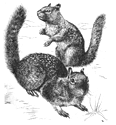Vertebrate Pest Conference Proceedings collection
Date of this Version
March 1976
Document Type
Article
Abstract
Current rodent control practices for the Hawaiian sugar industry revolve around the use of single grain baits containing anticoagulants in bait stations and zinc phosphide for aerial applications. Neither type of control programs as they are now applied has been very effective against the Norway rat (Rattus norvegicus) which is becoming a major problem species for the industry. As a result, we have sought a more effective anticoagulant, to which the Norway rat is more susceptible, and an improved method of bait distribution. With knowledge of the month-to-month variation in the field rodents' gestation rate, a new control program is being developed which involves the distribution of diphacinone oats in plastic bags to precede the major annual gestation peaks.

